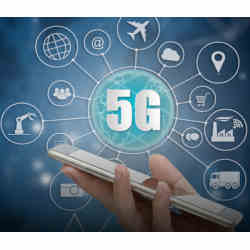
2020 was supposed to be the year that 5G, new fifth-generation wireless communications technology designed to provide data-speed enhancements of anywhere from 10 to 100 times what 4G can provide, along with lower latency and greater user capacity, was supposed to go mainstream, thanks to 5G-enabled devices and networks finally coming to market.
However, as lockdowns designed to slow the spread of the coronavirus were enacted around the world, they were projected to negatively impact production of 5G-enabled devices such as iPhones, as well as the chips used in 5G radios and base stations. With many consumers and businesses unable to generate revenue, the demand for new 5G-enabled devices was expected to slow, along with the work required to roll out the cellphone towers and other infrastructure needed to construct 5G networks.
The rapid spread of the COVID-19 virus wreaked havoc with the plans and goals of businesses, governments, and everyday consumers, as many jurisdictions enacted physical lockdowns to help slow the progression of the pandemic.
However, it appears the lockdown's impact on the development of the 5G networks has been minimal, according to market observers, carriers, and researchers. During the lockdown, traffic on city streets fell precipitously, actually making it easier to complete network construction projects.
"My sense is that [slowdowns in 5G buildout work] were highly location-specific," says Swarun Kumar, an assistant professor of electrical and computer engineering at Carnegie Mellon University. "There may have been hiccups due to the lockdowns, but I don't think 5G buildouts were going to come to a complete stop."
Indeed, as of July 2020, T-Mobile had enabled 5G coverage in parts of six metropolitan areas in the U.S., whereas Verizon had 5G coverage in 35 U.S. metro areas, and AT&T claimed 5G coverage in 45 states plus Washington, D.C. This list focuses solely on the use of high-speed millimeter-wave networks, which operate at higher frequencies (often at 28GHz or 39GHz) compared with 4G networks, which utilize frequency bands of 2.5GHz and below (T-Mobile also is rolling out low- and mid-band 5G, which are technically 5G technologies, but the higher frequency band permits greater bandwidth and higher data transfer speeds). High-frequency 5G's speed advantage comes at the expense of range, as well as greater susceptibility to signal blocking by things such as glass or concrete.
"Globally, we are seeing carriers marching full speed ahead to deploy 5G or in some cases, even accelerating their plans," says Michael O'Malley, vice president of strategy for Radware, a provider of security and application delivery solutions for physical, cloud, and software-defined datacenters. "Companies like Verizon have added $500 million to their CAPEX spend for 2020 to accelerate 5G and to provide increased speeds and capacity in light of the COVID pandemic, and another carrier, AT&T, plans to have nationwide 5G coverage by the end of 2020."
For carriers deploying high-frequency 5G, a greater density of wireless antennas is required to allow for proper signal propagation, with estimates indicating that 5G antennas will need to be placed within 500 feet of one another in a mesh configuration to ensure speeds remain consistent throughout the network. This introduces the challenge of navigating municipal bureaucracies to obtain approvals for site permits to place cell towers and antennas in a dense configuration, according to Sean Shahini, chief executive officer of Inorsa, Inc., an engineering company working with Verizon Wireless and other carriers to design and build out 5G networks.
"One of the biggest [challenges] in 5G rollout is having an understanding of bureaucracy and also getting through the permitting process," says Shahini, noting that city permit engineers and personnel find the high volume and dense concentration of antennas overwhelming to review and approve. "There has to be a process for them getting comfortable and understand what's happening."
One strategy for deploying a greater number of antennae is to place them inconspicuously on existing infrastructure, such as on streetlight poles, affixed to traffic control devices, or on other structures tall enough to provide wireless coverage without being unsightly or obstructive.
The growth of 5G is not limited to the U.S. South Korea, China, Saudi Arabia, Japan, and other markets around the world are actively supporting 5G, according to Shahini, although rollouts are likely to be slower in Latin America and parts of Africa where the average revenue per user is lower, according to O'Malley.
The coronavirus pandemic may have actually illustrated the need for 5G and other, more robust communications technologies. Due to lockdowns, more people are stuck at home, relying on their Internet connections for remote teleworking, remote healthcare visits, virtual schooling for their children, and connecting with loved ones they cannot visit in person. Similarly, businesses have accelerated efforts to allow not only workers to operate remotely, but also to enable more automation that requires reliable, fast connectivity to ensure operations continue smoothly, even when humans cannot physically oversee those operations.
The open question is whether cash-strapped consumers and businesses will be willing to shell out for 5G-enabled devices, which are often priced near the $1,000 mark (although new 5G chipsets from Qualcomm and others now making their way into devices may help to decrease the pricetag). Ultimately, carriers may take the same approach they did to drive 4G usage: offer lots of data on an unlimited basis, get customers hooked on the speed, and then slowly introduce higher prices and data caps in order to raise revenue to recoup network buildout costs.
"The everyday consumer doesn't yet have a 5G phone, at least one that will make full use of what 5G can truly offer," says Andrew Drozd, CEO of ANDRO Computational Solutions, LLC, a provider of research, engineering, and technical services to defense and commercial industries relating to electromagnetic spectrum and wireless communications. "I think in order to compete and grow during these difficult times, the economic strategy would be for the telcos to identify every possible financial incentive and assess cost-reduction usage plans to accelerate buy-in from the user community [and offset any stall due to COVID-19], and then once the rollout and adoption/use takes off, they can revert the model back to a more traditional supply-and-demand flat-fee approach."
Other market observers agree, noting that the industry typically uses incentives to spur demand when necessary, and then removes those incentives once there is an adequate amount of market traction.
"We've already seen the removal of data caps for the pandemic, and expect to see similar try-and-buy incentives extended after the pandemic," O'Malley says. "Service providers believe that once consumers have had the 5G experience, are able to use real-time applications on their mobile, and use the Internet at speeds they have only previously seen in wired connections, the service will have a high adoption rate."
Keith Kirkpatrick is principal of 4K Research & Consulting, LLC, based in Lynbrook, NY, USA.



Join the Discussion (0)
Become a Member or Sign In to Post a Comment